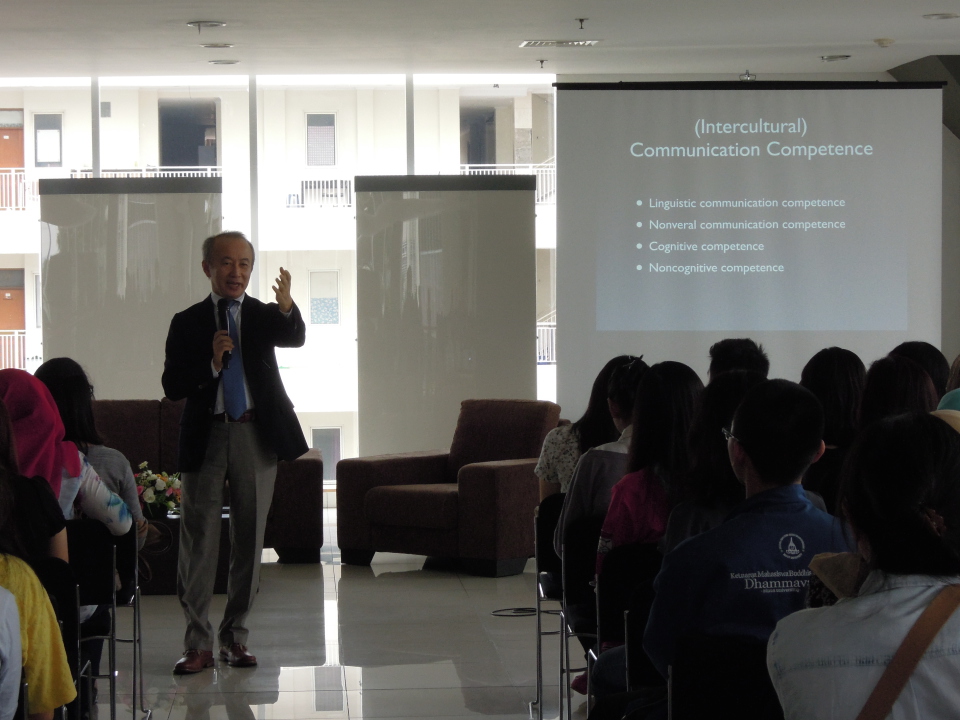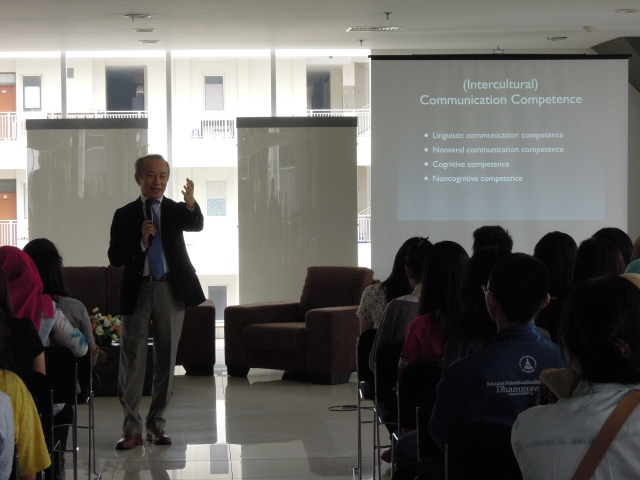The 16th IR Lecture Series: Intercultural Communication in Asia


Wednesday, February 27, 2015, International Relations Department BINUS University conducted The 16th IR Lecture Series in Exhibition Room, Anggrek Campus 3rd floor. In this occasion IR Department invited two professors from Ritsumeikan Asia Pacific University, Japan: Prof. Yuichi Kondo and Prof. Lailani Alcantara.
Prof. Kondo explained the competences that human beings need to develop in order to send or receive messages in the process of communication with other human beings in the society that creates – what-so-called- intercultural communication. In the second session of the seminar, Lailani L. Alcantara supported Kondo’s explanation by broadening up the subject to give a deeper understanding to the audience of how communication in the Asian region works.
Kondo mentioned that intercultural communication is defined as a form of information that is shared by the social group in the society to cope with different cultures through many ways, such as languages and human behaviors. Moreover, intercultural communication in the smaller area can be seen in an active communication between members of family. There are four important competences that need to be recognized in the intercultural communication to achieve a good set of knowledge and understanding of communication. These competences are linguistic communication competence, nonverbal competence, cognitive competence, and non-cognitive competence.
First of all, Kondo explained that an individual should have the ability to speak one or more foreign languages, as it promises a better opportunity in the working field. As Kondo said, “language has a price,” it opens up bigger possibility to get a job with higher salary. As every human being has different level in learning languages, those with better linguistic skills will have higher possibility to get hired when they apply for jobs. Furthermore, language also helps us to understand and see more things that we have never seen before, and it gives us the chance to see things from different perspectives. The second factor is nonverbal competence that is believed to carry more information than verbal messages. It is scientifically proven that nonverbal messages deliver around 60% in the process of communication in the society. People use the nonverbal behaviors unconsciously to communicate with other people as nonverbal behaviors have culturally defined grammar that create culture bound and an individual has to have the ability to make an appropriate space. The next competence is cognitive, which is a skill to have broad knowledge about the world and ability to search, select, and edit the information to complete the received information in the realization of intercultural communication. By using or selecting words, different perspective will be achieved and this is a form of cognitive complexity. Moreover, non-cognitive competence is believed as the last competence that supports the intercultural communication, this kind of competence can be seen in the form of flexibility, tolerance for ambiguity, resilience, grit, and the will to commit or engage in social issues.
Furthermore, the improvement of communication competence can be accomplished by improving academic curriculum, co-curriculum, and field work or experience. Active learning in practice, as in the class room, can help to complete learning in the field of experience and vice versa. It is described as cycle of learning.

Alcantra added some specific examples of Kondo’s explanation of intercultural communication by presenting the communication in Asia. She explained that culture can be defined as a set of knowledge, beliefs, values, moral, capabilities, and habits, as a way of life of a group of people, and a form of collective programming of the mind. Moreover, culture also is a tool to filter the messages that are sent from an individual to the other individuals. Many people use indirect way to deliver certain messages that impact the result that causes misunderstanding of the intended message, and this is also supported by the nonverbal communication or messages that are seen as different meanings by some people. To understand intercultural communication in Asia, it is important to identify the Asian values such as respect for authority, family, social conformity, and social status. Not only that, cultural dimension such as power distance, individualism, masculinity, uncertainty avoidance index, are also important to maintain the relations in conducting the intercultural communication. However, to manage or reach effective communication, it is needed to assume differences until similarity is proven, use the other culture’s lens, and use communication as relationship management.
In conclusion, to achieve effective intercultural communication between individuals, intercultural communication needs to be supported by four competences such as linguistic communication competence, nonverbal competence, cognitive competence, and non-cognitive competence. Not only that, by defining culture, mastering verbal languages, and understanding nonverbal language, it can help individuals to do better in conducting intercultural communication in the society.
[Dewi Mulyasari, IR BINUS Student Binusian 2017]
